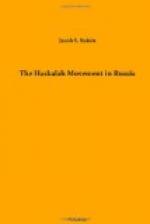In philosophy, mathematics, and medicine, the three main branches of medieval knowledge, many Slavonian Jews attained eminence. Devout Karaites as well as diligent Talmudists found secular learning a diversion and a delight. For the lovers of enlightenment Italy, especially Padua, was the centre of attraction, as France and Spain had been before, and Germany, particularly Berlin, became afterwards.[30] Towards the middle of the sixteenth century we find young Delacrut at the University of Bologna, the philosopher and Cabbalist, known for his commentaries to Gikatilla’s Sha’are Orah (Cracow, 1600) and Ben Avigdor’s Mar’eh ha-Ofanim (1720), and his translation of Gossuin’s L’image du monde (Amsterdam, 1733). His famous disciple Mordecai Jaffe (Lebushim) spent ten years in the study of astronomy and mathematics before he occupied the rabbinate of Grodno (1572)[31] At the request of Yom-Tob Lipman Heller, Joseph ben Isaac Levi wrote a commentary on Maimuni’s Moreh Nebukim, which was published with the former’s annotations, Gibe’at ha-Moreh (Prague, 1611). Deservedly or not, Eliezer Mann was called “the Hebrew Socrates”; and many a Maskil in his study of mathematics turned for guidance to Manoah Handel of Brzeszticzka, Volhynia, author and translator of several scientific works, who rendered seven Euclidean propositions into Hebrew.[32]
Polyglots they were compelled to be by force of circumstances. When the exotic Judeo-German finally asserted itself as the vernacular, the language in which they wrote and prayed was still the ancient Hebrew, with which every one was familiar, and commercial intercourse with their Gentile neighbors was hardly feasible without at least a smattering of the local Slavonic dialect. “Look at our brethren in Poland,” exclaims Wessely many years later in his address to his countrymen. “They converse with their neighbors in good Polish.... What excuse have we for our brogue and jargon?” He might have had still better cause for complaint, had he been aware that the Yiddish of the Russo-Polish Jews, despite its considerable Slavonic admixture, was purer German than that of




